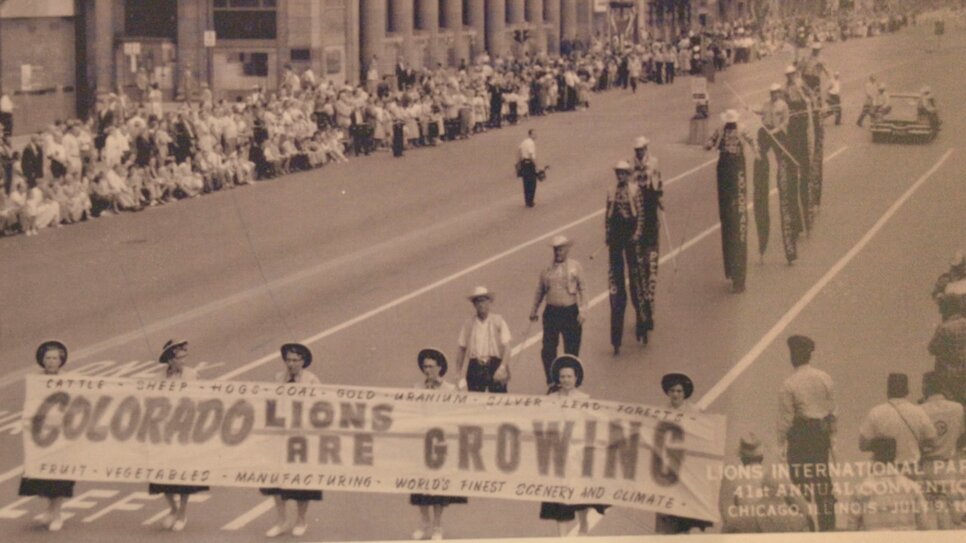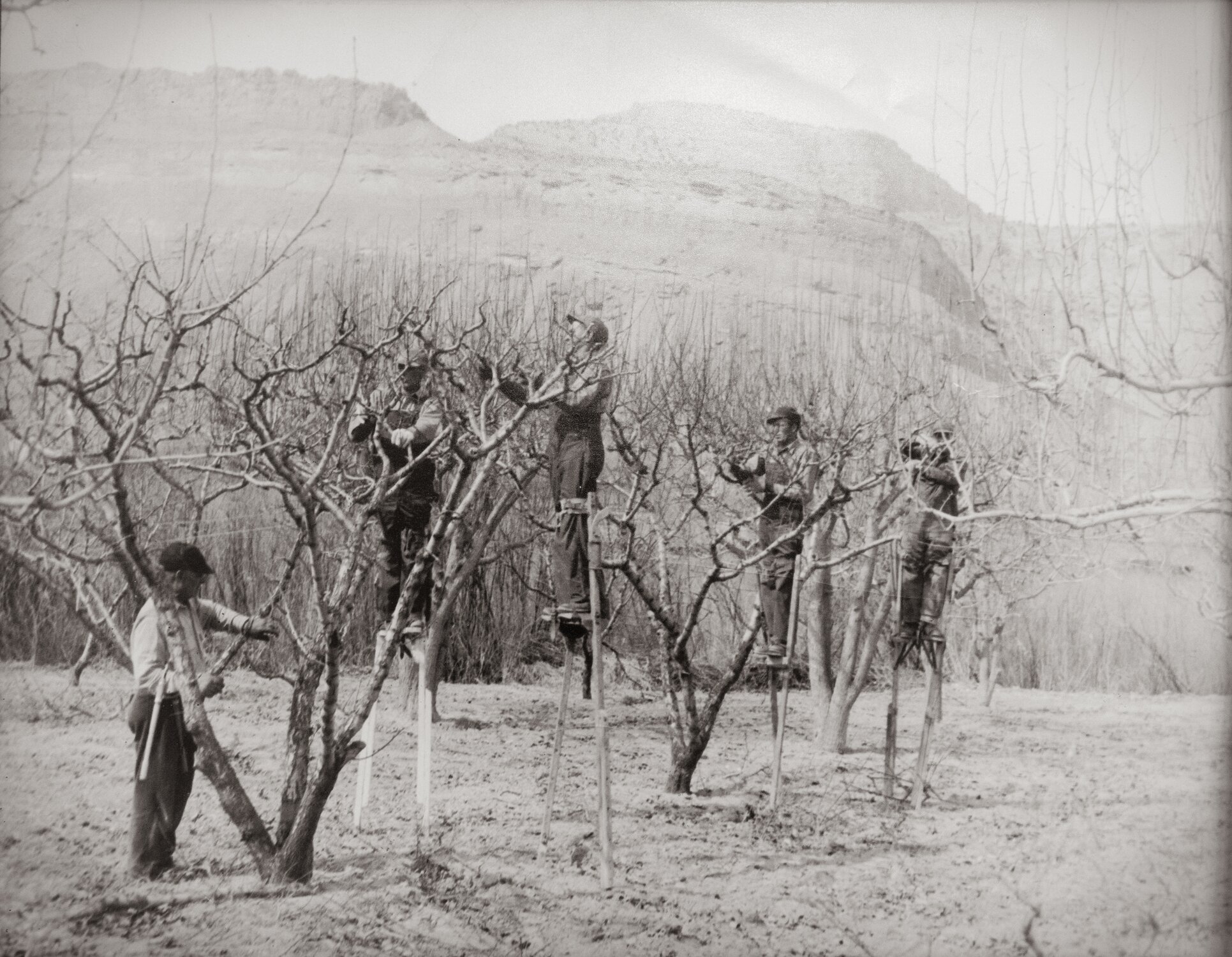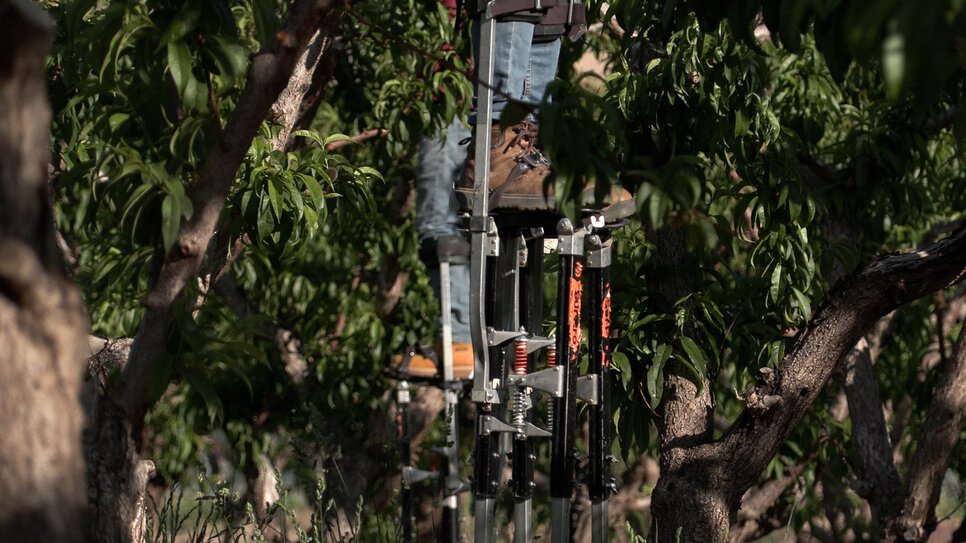Stilt crazy after all these years: Harvesting peaches from up on high
share

Rocky Mountain PBS is producing a documentary about the peach industry in Palisade. This and other stories will examine the business and culture around peaches throughout the year.
PALISADE, Colo. — Peach trees in the Grand Valley used to be much taller than they are today.
“In the early part of the 20th century, we see that the trees were tall, and the ladders to get up to them, we have pictures of 20 foot, A-shaped ladders. And then shortly after that, the stilts showed up,” said Priscilla Walker, founding chair of the Palisade Historical Society.
It’s believed that resident E.T. Schneller came up with the idea of using 5-foot tall stilts for orchard work in 1915, according to the historical society.
Farm workers used stilts, much like what a circus performer would wear, to prune the tall trees and pick peaches for the following decades. Photos at the history museum in Palisade show people working on stilts into the 1940s and 50s.
The midpoint of the 20th century was a heyday for the peach industry in Palisade.
Producer co-ops and marketing associations sold millions of pounds of peaches from the valley far across the country, thanks to refrigerated train cars, sometimes filling hundreds of cars a day during harvest.
In 1949 you could buy a box of Palisade peaches for about $1, according to an issue of The Rocky Mountain News from August of that year.
The Palisade Lions Club sent fruit growers to Chicago and New York to walk in parades with banners advertising Colorado peaches and wore stilts as part of the promotion.

Fruit growers from Palisade advertise Colorado peaches at a Lions Club parade in Chicago in 1958.
Courtesy Palisade Historical Society.
Courtesy Palisade Historical Society.
“You would get a ladder and you'd go to the top of a roof of the packing shed and you'd put the stilts on and then stand up and then walk in the orchard. But you could thin and prune much faster than with the ladder,” said Walker.
A newsreel from 1944 features folks on stilts in a Palisade orchard. There aren’t many mentions of the use of stilts for orchard work in online newspaper archives, but the earliest is from 1915 in Paonia, also in western Colorado. A man named John Beezley is described as saving time by strapping stilts to his legs, instead of using a ladder to prune peach trees.
In California, meanwhile, LIFE Magazine photographer Ralph Crane took a series of pictures with farmers who used stilts in their orchards in 1960.
The giant stilts may have been more efficient than constantly moving a ladder through an orchard, but they were also dangerous, and difficult to learn.
“When I grew up, there's a lot of people still walking [on] stilts. I was never real proficient at it, I'll be honest,” said Dennis Clark. His family has been growing fruit in Palisade for generations. The Clark Family Orchards farm stand is covered in old photos. One shows Clark’s grandfather pruning trees on stilts.
Clark remembers the gangly wooden stilts were so pervasive that for years, the community would have races on the stilts during the 4th of July celebrations.

Dennis Clark's grandfather, Jamie Clark, prunes on stilts in the 1940s with four other men in an orchard in Palisade.
Photo courtesy Dennis Clark
Photo courtesy Dennis Clark
Now, different varieties of trees are smaller and easier to manage. They’re bred that way intentionally, and also give farmers options for how early or late a harvest they want from each type of tree.
However, one company has found stilts to be useful again.
Bruce Talbott, the orchard manager at Talbott’s Mountain Gold, said the workers at their orchard in Palisade use drywall stilts, like the kind home contractors use to reach ceilings and high walls.
“They're better stilts,” Talbott said. “They're easier to walk. You don't have to be as skilled. And we do have shorter trees.”

Workers in an orchard at Talbott's Mountain Gold use stilts to prune peach trees in spring.
Photo: Joshua Vorse, Rocky Mountain PBS
Photo: Joshua Vorse, Rocky Mountain PBS
In one of the orchards Talbott oversees, workers deftly secure the stilts to their boots to thin trees in late spring. A few extra feet of height make it easy to move around each tree, brushing off golf-ball sized peaches, so the fruit that’s left can get as much sun and nutrients as possible.
The large fruit growing operation moved away from using ladders for orchard work like thinning and pruning around three years ago.
“The stilts have given us an efficiency that’s been very helpful,” said Talbott.
